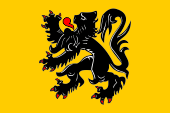Flandern |
|
|
|
| Übersicht – Contents: | |
Diese Seite ist Teil des Projektes
Flandern |
|
|
|
| Übersicht – Contents: | |
Flagge – Flag: |
|
 |
Flagge von Flandern – flag of Flanders, Seitenverhältnis – ratio = 2:3, Quelle/Source nach/by: Flags of the World |
Bedeutung/Ursprung der Flagge – Meaning/Origin of the Flag: |
|
| Die alte Grafschaft Flandern zeigte Gelb und Blau geständert, mit einem roten Herzschild. Vermutlich unter der Herrschaft der Habsburger (seit 1482) bekam die Grafschaft Flandern ein anderes Wappen verliehen. Es zeigte einen schwarzen, rot bewehrten Löwen auf Gold, eine Symbolik die heute noch sehr bekannt und weit verbreitet ist, nicht zuletzt als Symbol für Flandern als föderaler Bestandteil des heutigen Belgiens. |
The old county of
Flanders showed gyronny yellow and blue with a red heart shield. Probably
under the rule of the Habsburgs (since 1482), the county of Flanders was
handed over a new coat of arms. It showed a black, red armored lion on gold, a symbolism that is still very well known and widespread today, not least as a symbol for Flanders as a federal part of today's Belgium. |
| Quelle/Source: Volker Preuß | |
|
Lesen Sie hier: Hintergründe, Geschichte und Fakten zum Thema "Der Löwe in der Heraldik". Ausführungen, Varianten, Entwicklung sowie Panther und Leoparden. |
 |
| Landkarten – Maps: |
Lage in Belgien – Position in Belgium: |
Zahlen und Fakten – Numbers and Facts: |
|
|
|
|
|
|
|
|
|
|
|
|
|
|
|
|
|
|
|
58–51 v.Chr. · römische Eroberung 3. Jahrhundert n.Chr. · Besiedlung durch Franken und Friesen 481–843 · zum Frankenreich 880 · Vertrag von Verdun und Ribbemont, bei der Teilung des Frankenreiches kommt Westflandern an das Westfränkische Reich (Frankreich) und Ostflandern an das Ostfränkische Reich (Deutsches Reich) 1051 · Balduin VI. (von Westflandern) vereinigt Flandern und die Grafschaft Hennegau durch Heirat 1384 · durch Heirat kommt Flandern an Burgund und an das Deutsche Reich 1482 · Flandern wird Habsburgischer Besitz 1556 · Flandern kommt an die spanische Linie des Hauses Habsburg 1795 · Eroberung und Annexion durch Frankreich 1815–1830 · zu den Vereinigten Niederlanden 1830 · Gründung Belgiens mit dem Ziel ein französischprachiger Staat zu werden, Flandern wird Belgien angeschlossen ca. 1840 · Gründung der „Flämischen Bewegung“ zum Erhalt der Flämischen Sprache und Kultur ca. 1880 · Gründung der „Wallonischen Bewegung“ als Widerpart 1898 · „Gleichheitsgesetz“, Belgien wird offiziell ein zweisprachiger Staat 1962–1963 · Festlegung der Sprachgrenze zwischen den Kulturgemeinschaften, Brüssel wird zweisprachig, Anerkennung der Deutschen Sprache als Regionalsprache in Ostbelgien 1970 · erste belgische Staatsreform, die Kulturgemeinschaften erhalten Verfassungsrang 1980 · zweite belgische Staatsreform, Schaffung der Flämischen Region mit Autonomiestatus 1988 · dritte belgische Staatsreform, Ausbau der Autonomie der Regionen, Schaffung der Region Brüssel-Hauptstadt 1994 · vierte belgische Staatsreform, Teilung der ehemaligen Provinz Brabant, weiterer Ausbau der Autonomie der Regionen, Belgien wird föderaler Bundesstaat 2001 · fünfte belgische Staatsreform, weiterer Ausbau der Autonomie der Regionen |
|
58–51 B.C.
· Roman conquest 3rd Century A.D. · settlement by Franks and Frisians 481–843 · to the Frankonian Empire 880 · Treaty of Verdun and Ribbemont, by the division of the Frankish Empire comes West-Flanders to the West Frankish kingdom (France) and East-Flanders to the East Franconian Empire (German Empire) 1051 · Balduin VI. (West Flanders) unites by marriage Flanders and the County of Hainaut 1384 · Flanders comes to Burgundy and to the German Empire by marriage 1482 · Flanders becomes a Habsburg possession 1556 · Flanders comes to the Spanish lineage of the House of Habsburg 1795 · conquest and annexation by France 1815–1830 · to the United Netherlands 1830 · creation of Belgium with the aim of a French speaking state to be, Flanders becomes annexed to Belgium about 1840 · foundation of the "Flemish movement" to preserve the language and Flemish culture about 1880 · foundation of the "Walloon movement" as an adversary 1898 · "Equality Act", Belgium is officially a bilingual country 1962–1963 · Definition of the linguistic border between the cultural communities, Brussels is bilingual, recognition of the German language as a regional language in Eastern Belgium 1970 · first Belgian state reform, the cultural communities become an constitutional rank 1980 · second Belgian state reform, creation of the Flemish Region with status of autonomy 1983 · creation of the German Community in Eastern Belgium as part of Wallonia 1988 · third Belgian state reform, expansion of regional autonomy, creation of the Region Brussels-Capital 1994 · fourth Belgian state reform, division of the former province of Brabant, further strengthening of the autonomy of regions, Belgium becomes a federal state 2001 · fifth Belgian state reform, further strengthening of the autonomy of the regions |
| Quelle/Source: Atlas zur Geschichte, Wikipedia (D) |
Ursprung des Landesnamens – Origin of the Country's Name: |
|
| Der Name "Flandern" geht auf das alte Wort "Fladmari" zurück, was "flaches Marschland" heißt, und zu Beginn eigentlich nur die Gegend um die Stadt Brügge bezeichnete. | The name "Flanders" goes back the old word "Fladmari", what means "shallow marshes" and it stated at the beginning only the area around the city of Bruges. |
| Quelle/Source: Handbuch der geographischen Namen | |